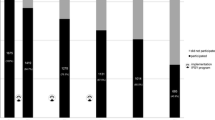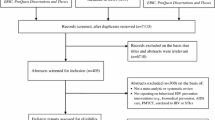Abstract
Psychosocial tobacco use prevention programs are based on the assumption that refusal skills training will have a suppressive effect on the onset of use by enabling non-using adolescents to refuse offers of cigarettes and smokeless tobacco. The present study investigated this assumption with 389 high-risk junior high-school students involved in a prevention program during their seventh, eighth, and ninth-grade years. Direct behavioral measures of refusal skills were taken by having subjects respond to audiotaped offers of tobacco and then rating the quality of their responses. These ratings were then linked to tobacco use measures obtained at the end of each of the 3 study years. Results showed that the comprehensive prevention program produced a favorable trend in delaying or preventing the onset of tobacco use. However, the refusal skills training, which was carried out throughout the 3-year intervention period, produced significant differences in overall refusal skill quality only at the seventh grade. Moreover, refusal skill quality was not related to overall tobacco use or cigarette use at any grade.
Similar content being viewed by others
References
Cummings, S. R., Rubin, S. M., and Oster, G. (1989). The cost-effectiveness of counseling smokers to quit.JAMA 261: 74–79.
Elder, J. P., Wildey, M., de Moor, C., Sallis, J. F., Eckhardt, L., and Edwards, C. (1993). The long-term prevention of tobacco use among junior high school students: Classroom and telephone interventions.Am. J. Publ. Health. 83: 1239–1244.
Evans, R. I., and Raines, B. E. (1982). Control and prevention of smoking in adolescents: A psychological perspective. In Coates, T. J., Peterson, A. C., and Perry, C. (eds.),Promoting Adolescent Health: A Dialogue on Research and Practice, Academic Press, New York, pp. 101–136.
Evans, R., Hansen, W., and Mittelmark, M. (1977). Increasing the validity of self-reports of smoking behavior in children.J. Appl. Psychol. 62: 521–523.
Flay, B. R. (1985). Psychosocial approaches to smoking prevention: A review of the findings.Health Psychol. 4: 449–488.
Glynn, T. J., Anderson, D. M., and Schwartz, L. (1991). Tobacco-use reduction among high-risk youth: Recommendations of a National Cancer Institute expert advisory panel.Prevent. Med. 20: 279–291.
Hops, H., Weissman, W., Biglan, A., Thompson, R., Faller, C., and Severson, H. H. (1986). A taped situation test of cigarette refusal skills among adolescents.Behav. Assess. 8: 145–154.
MacKinnon, D. P., Johnson, C. A., Pentz, M. A., and Dwyer, J. H. (1991). Mediating mechanisms in a school-based drug prevention program: First-year effects of the Midwestern Prevention Project.Health Psychol. 10: 164–172.
Marcus, A. C., and Crane, L. A. (1985). Smoking behavior among Hispanics: A preliminary report.World Smoking and Health, Spring.
McCaul, K. D., and Glasgow, R. E. (1985). Preventing adolescent smoking: What have we learned about treatment construct validity?Health Psychol. 4: 361–387.
Pierce, J. P., Fiore, M. C., Novotny, T. E., Hatziandreau, E. J., and Davis, R. M. (1989). Trends in cigarette smoking in the United States: Projections to the year 2000.JAMA 261: 61–65.
Sallis, J. F., Elder, J. P., Wildey, M. B., de Moor, C., Young, R. L., Shulkin, J. J., and Helme, J. M. (1990). Assessing skills for refusing cigarettes and smokeless tobacco.J. Behav. Med. 13: 489–503.
Schinke, S. P., Gilchrist, L. D., and Snow, W. H. (1985). Skills intervention to prevent cigarette smoking among adolescents.Am. J. Publ. Health 74: 665–667.
Schinke, S. P., Gilchrist, L. D., Schilling, R. F., Snow, W. H., and Bobo, J. K. (1986). Skills methods to prevent smoking.Health Educ Q. 13: 23–27.
Sussman, S., Dent, C. W., Stacy, A. W., Sun, P., Craig, S., and Simon, T. R. (1993). Project Towards No Tobacco Use one-year behavior outcomes (under review).
U.S. Department of Health and Human Services (1986). The health consequences of using smokeless tobacco. A report of the advisory committee to the surgeon general, 1986. USDHHS Public Health, Service NIH Publication No. 86-2874.
U.S. Department of Health and Human Services (1989). Reducing the health consequences of smoking: 25 years of progress. A report of the surgeon general. USDHHS Publication No. (CDC) 89-8411.
U. S. Public Health Service (1964). Smoking and health. Report of the Advisory Committee to the Surgeon General of the Public Health Service. USDHHS Public Health Service, PHS Publication No. 1103.
Author information
Authors and Affiliations
Additional information
This work was supported by Grant R01-CA44921 from the National Cancer Institute.
Rights and permissions
About this article
Cite this article
Elder, J.P., Sallis, J.F., Woodruff, S.I. et al. Tobacco-refusal skills and tobacco use among high-risk adolescents. J Behav Med 16, 629–642 (1993). https://doi.org/10.1007/BF00844723
Accepted:
Issue Date:
DOI: https://doi.org/10.1007/BF00844723




